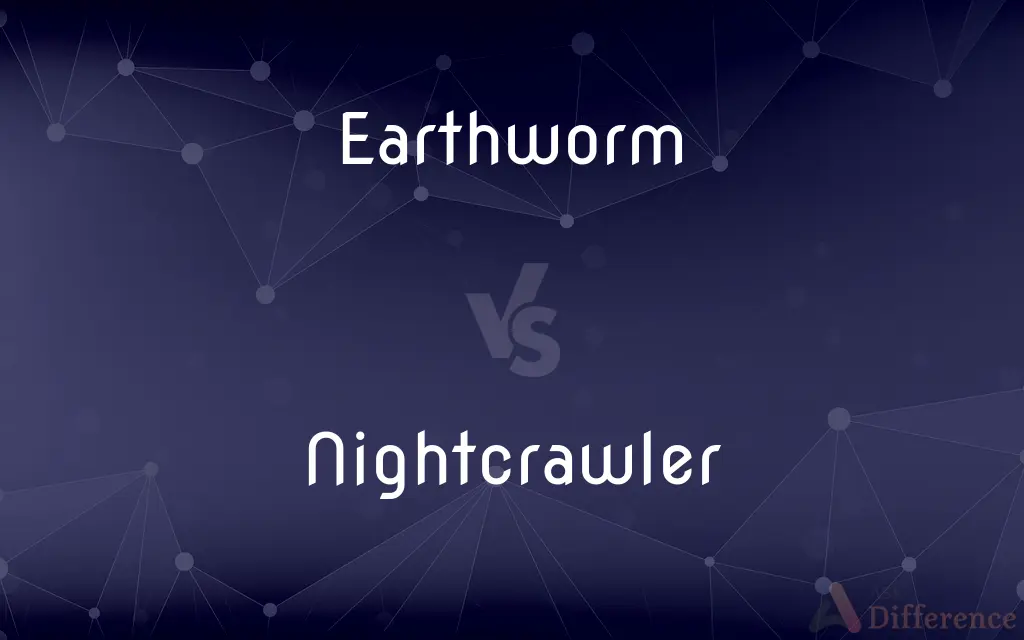Earthworm vs. Nightcrawler — What's the Difference?
Edited by Tayyaba Rehman — By Fiza Rafique — Updated on November 2, 2023
Earthworms are soil-dwelling worms; nightcrawlers are a type of large earthworm active at night and favored for fishing.

Difference Between Earthworm and Nightcrawler
Table of Contents
ADVERTISEMENT
Key Differences
Earthworms are segmented invertebrates belonging to the class Oligochaeta. They live within the soil, playing a crucial role in soil health and fertility. Nightcrawlers, on the other hand, are a specific type of earthworm known scientifically as Lumbricus terrestris. While all nightcrawlers are earthworms, not all earthworms are nightcrawlers. Nightcrawlers are recognized for their size and nocturnal activity.
The typical earthworm can be found in various environments, from gardens to forests, contributing to composting and aeration of soil. Nightcrawlers are particularly noted for their deep burrowing habits and are often seen on the soil surface at night. These creatures are sought after for bait due to their size and movement, which is attractive to fish.
When it comes to reproduction, earthworms are hermaphrodites and can regenerate if split. Nightcrawlers share these traits but are often more robust and can survive in harsher conditions due to their ability to burrow deeply. The biology of earthworms and nightcrawlers is similar, but their behavior and environmental roles have distinctive characteristics.
In terms of appearance, earthworms may vary in size and color, ranging from a few centimeters to over a meter in tropical species. Nightcrawlers are usually larger than the average earthworm and are identified by their darker, reddish-brown coloring. This size difference makes nightcrawlers particularly noticeable and distinctive among the earthworm species.
While both earthworms and nightcrawlers enrich the soil by processing organic matter, the nightcrawler's ability to bring subsoil closer to the surface has a significant impact on soil quality. They can be used interchangeably in vermiculture, but the nightcrawler's preference for cooler temperatures often dictates their use in temperate climates.
ADVERTISEMENT
Comparison Chart
Scientific Name
Various genera
Lumbricus terrestris
Size
Generally smaller
Larger and longer
Activity
Diurnal and nocturnal
Primarily nocturnal
Habitat
Topsoil and rich humus
Deeper soil layers
Use
Composting, soil health
Fishing bait, soil aeration
Compare with Definitions
Earthworm
A segmented invertebrate aiding in soil aeration.
The earthworms in my garden keep the soil healthy.
Nightcrawler
A worm species that can regenerate its segments.
The nightcrawler cut in half by the spade will survive.
Earthworm
A hermaphroditic soil dweller.
The earthworm population has doubled since last spring.
Nightcrawler
A reddish-brown earthworm known for aerating deep soil.
The presence of nightcrawlers indicates healthy soil.
Earthworm
A common garden organism promoting composting.
I found an earthworm near the compost bin.
Nightcrawler
A large, nocturnal earthworm species used as fishing bait.
I bought nightcrawlers for our fishing trip tomorrow.
Earthworm
A worm that lives in the ground.
Nightcrawler
A deep-burrowing worm visible on the ground at night.
Nightcrawlers often come out on the lawn after dark.
Earthworm
An earthworm is a terrestrial invertebrate that belongs to the phylum Annelida. They exhibit a tube-within-a-tube body plan, are externally segmented with corresponding internal segmentation, and usually have setae on all segments.
Nightcrawler
Any of various large earthworms that dig deep burrows in the ground and emerge at night. They are often used as fish bait.
Earthworm
Any of various terrestrial annelid worms of the class Oligochaeta, especially those of the family Lumbricidae, that burrow into and help aerate and enrich soil.
Nightcrawler
An earthworm of the species Lumbricus terrestris, known for its large size and nocturnal surfacings.
Earthworm
A worm of the family Lumbricidae, or, more generally, of the suborder Lumbricina.
Nightcrawler
More generally, any arbitrarily large earthworm, especially those favored in angling.
Earthworm
(figurative) A contemptible person; a groveller.
Nightcrawler
A terrestrial worm that burrows into and helps aerate soil; an earthworm. It often surfaces when the ground is cool or wet, and is used as bait by anglers. The term is used mostly in the northern and western U. S.
Earthworm
Any worm of the genus Lumbricus and allied genera, found in damp soil. One of the largest and most abundant species in Europe and America is L. terrestris; many others are known; - called also angleworm and dewworm.
Nightcrawler
Terrestrial worm that burrows into and helps aerate soil; often surfaces when the ground is cool or wet; used as bait by anglers
Earthworm
A mean, sordid person; a niggard.
Nightcrawler
A type of earthworm sold in bait shops.
Nightcrawlers are more expensive than other bait worms.
Earthworm
Terrestrial worm that burrows into and helps aerate soil; often surfaces when the ground is cool or wet; used as bait by anglers
Earthworm
A small, cylindrical, tube-like creature.
An earthworm squirmed on the wet pavement after the rain.
Earthworm
A burrowing animal enriching soil fertility.
Earthworms are vital for organic farming practices.
Common Curiosities
What is an earthworm?
An earthworm is a small, tube-shaped, segmented worm that lives in the soil.
Can you use earthworms for fishing?
While smaller, earthworms can be used for fishing, but nightcrawlers are preferred.
Are nightcrawlers good for gardens?
Yes, nightcrawlers are beneficial for gardens due to their soil aeration abilities.
How do earthworms help soil?
Earthworms help by breaking down organic matter, aerating, and fertilizing the soil.
Do nightcrawlers come out during the day?
Nightcrawlers typically surface at night, hence their name, but can occasionally be seen during the day, especially when the ground is wet.
What is a nightcrawler?
A nightcrawler is a large, nocturnal type of earthworm often used for fishing bait.
What do earthworms eat?
Earthworms eat decaying plant material, soil, and microorganisms.
What's the best way to find earthworms?
Earthworms can be found by digging in moist, rich soil or waiting for them to surface after rain.
Why are nightcrawlers more expensive than other worms?
Due to their size and desirability for fishing, nightcrawlers are often in high demand, making them more expensive.
Can earthworms regenerate if cut in half?
Only certain species can regenerate, and usually only the front half survives.
How do earthworms move?
Earthworms move by contracting and extending their muscles and bristling their setae for grip.
Are all nightcrawlers earthworms?
Yes, all nightcrawlers are a specific type of earthworm.
Can nightcrawlers be harmful?
In non-native environments, nightcrawlers can disrupt soil layers and harm local ecosystems.
What do nightcrawlers eat?
Like other earthworms, nightcrawlers consume organic matter and soil.
How long do nightcrawlers live?
Nightcrawlers can live up to 6 years under optimal conditions.
Share Your Discovery

Previous Comparison
Concept vs. Definition
Next Comparison
Addressee vs. SenderAuthor Spotlight
Written by
Fiza RafiqueFiza Rafique is a skilled content writer at AskDifference.com, where she meticulously refines and enhances written pieces. Drawing from her vast editorial expertise, Fiza ensures clarity, accuracy, and precision in every article. Passionate about language, she continually seeks to elevate the quality of content for readers worldwide.
Edited by
Tayyaba RehmanTayyaba Rehman is a distinguished writer, currently serving as a primary contributor to askdifference.com. As a researcher in semantics and etymology, Tayyaba's passion for the complexity of languages and their distinctions has found a perfect home on the platform. Tayyaba delves into the intricacies of language, distinguishing between commonly confused words and phrases, thereby providing clarity for readers worldwide.














































